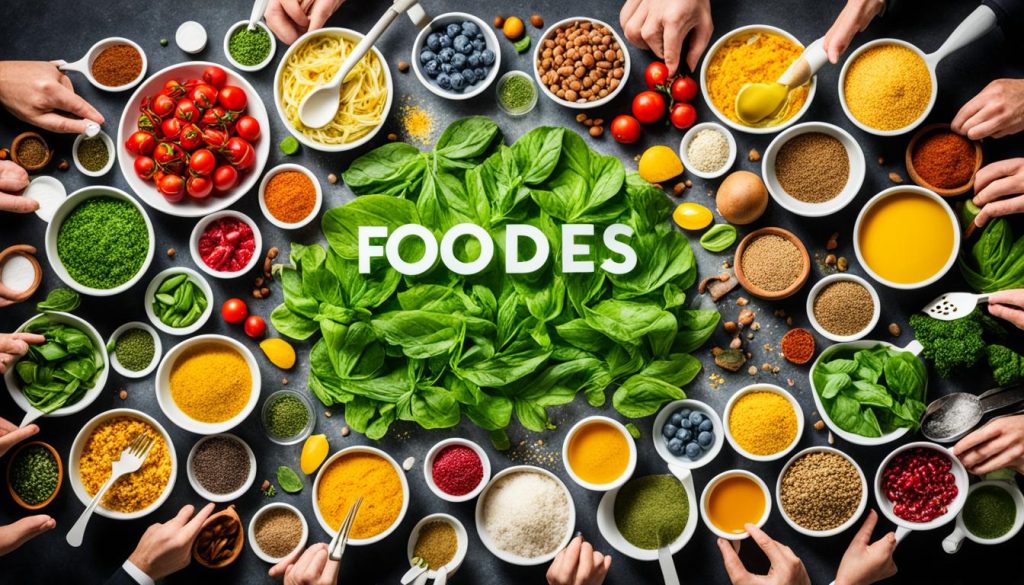Keeping up with food industry news is key for those in the culinary world. This field is always changing, thanks to new trends, tech, and rules. These changes affect what we eat and how we experience dining out. By keeping an eye on the latest news, we can understand how the market impacts our choices.
This article will cover the food industry’s many sides. It aims to give a broad view before diving deeper into specific topics later.
Key Takeaways
- The food industry is rapidly changing due to emerging trends and technological advancements.
- Understanding food industry news can help consumers make informed dining choices.
- Staying informed about regulations is essential for businesses within the culinary landscape.
- There’s a growing emphasis on sustainability and health-conscious eating.
- Insights into consumer preferences can shape successful menu adaptations.
Overview of the Food Industry Landscape
The food industry is a complex mix of different sectors. Each one adds important insights to the market. This includes restaurants, food processing, and retail. It’s key to look at each part to understand the market better.
Competition is strong in the dining and food production world. Companies are working hard to meet changing consumer needs. They focus on quality and being sustainable. With more people caring about health and wellness, they want products that match these values. This affects the food industry a lot.
- The growing importance of sustainable practices across all segments.
- Changes in consumer preferences, particularly towards healthier and organic alternatives.
- Innovative technologies reshaping food processing and production.
As the food industry changes, businesses need to keep up with market trends. These trends help shape their strategies. They are key to understanding new trends and innovations in the food sector.
Emerging Food Trends
The food industry is always changing, thanks to new consumer interests and values. Now, we see a big shift towards plant-based diets and health-conscious eating. This shows a big change in what people want to eat.
Plant-Based Diets on the Rise
More people are choosing plant-based diets for a healthier life. This is because they learn about the bad effects of meat on the environment and their health. They look for vegetarian and vegan options for their health and ethical reasons.
Restaurants and food brands are taking notice. They are coming up with new meat alternatives and adding more plant-based choices to their menus.
Health-Conscious Eating Patterns
Health-conscious eating is also on the rise. People want to choose foods that are good for them and know what’s in them. They prefer whole foods and avoid processed ones.
They’re eating more fruits, vegetables, and whole grains. This change is affecting menus in restaurants and what’s available in stores. It shows a big impact on the future of food production.
Culinary Innovations Changing Menus
Restaurants are now seeing a big change with new cooking methods. These new ways make old dishes into something new and exciting. They mix different cuisines together, offering unique tastes that draw in many customers.
Food technology is key to these changes. It helps keep food fresh and makes flavors pop. Chefs use these tools to make new dishes that stand out.
In a crowded market, being different is key. New cooking methods bring in customers and keep them coming back. By using these new ideas, restaurants can meet the changing tastes of their customers. This leads to a more exciting dining scene.
Sustainable Food Systems in Focus
The idea of sustainable food systems is getting more attention as climate change effects grow. It’s crucial for changing farming ways that harm the environment. Farmers and producers must change their methods to handle climate changes.
Impact of Climate Change on Agricultural Practices
Climate change threatens agriculture, affecting crop yields and food stability. Unstable weather changes planting times, pest problems, and resource availability. To fight these issues, many are using new farming methods that focus on sustainability. These include regenerative farming, managing pests better, and saving water.
Customer Demand for Eco-Friendly Options
More people know about environmental problems, changing what they buy. Now, customers look for eco-friendly food sources, packaging, and production. Brands that focus on sustainability get more loyal customers. This shift shows the need for sustainable food systems.
Food Processing Techniques: Modern Advances
New changes in the food processing world have changed the game. These changes aim to make food safer and more efficient by using new tech. By using modern ways to process food, companies can make better products and keep customers healthy.
Technological Innovations in Food Safety
Now, food safety depends a lot on new tech. With better monitoring systems, companies can keep a closer eye on food quality and safety. For example, sensors and data analytics give updates on temperature and contamination in real-time.
This way, companies can protect consumers and meet strict rules more easily.
Automation in Food Production
Automation is key in changing how we make food. With the help of robots and AI, food production gets more efficient. This means less work for people and more food made faster.
Food Safety Regulations: Current Updates
Food safety rules are changing to meet new challenges in the food industry. As people learn more about food safety, it’s clear how important it is. New rules help keep everyone safe by tackling risks and making sure food is safe.
New Standards and Compliance Requirements
Groups that focus on food safety keep updating their rules to fight off food illnesses. Now, they stress the need for well-trained food handlers and detailed records. These steps make sure food is safe, which makes people trust it more.
Enhanced Inspection Protocols
How we inspect food has changed a lot to make it safer. Now, we use new tech and methods for better checks. These updates help meet safety rules and stop food dangers before they start. Regular checks are key to keeping food quality high, so people know their food is safe.

Restaurant Industry Updates
The restaurant industry has changed a lot, especially with what customers want now. More people want delivery and takeout, so restaurants are changing to meet this need. This big change is making restaurants work differently, showing a big shift in how we eat out.
Shift to Delivery and Takeout Models
Restaurants are now focusing on delivery and takeout to keep up during tough times. This move is because more customers want things to be easy and quick. The main changes are:
- Enhanced online ordering systems to make ordering easier.
- Innovative packaging to keep food fresh while it’s being carried.
- Menu adjustments for takeout that are easy to eat and look good.
Adaptations in Dining Experiences
As things change, so do dining experiences. Restaurants are finding new ways for customers to enjoy their space. These changes are important for safety and making customers happy. They include:
- Social distancing measures in dining areas.
- Technological integrations like contactless payments and digital menus.
- Creative outdoor dining arrangements to make customers more comfortable.
Agribusiness Insights for the Future
The agribusiness world is changing fast, showing why we need to focus on agribusiness insights for the future of farming. Today’s food production faces big challenges that call for new solutions, especially in farming technology. This tech helps farmers work smarter, not harder, by making the most of every resource.
Agile agribusinesses know they must change to keep up with growing food needs and stay sustainable. Using less harm to the environment is now key. Sustainable farming tech is crucial, offering tools that boost output and cut down on waste.
- Using precision agriculture systems helps farmers use water and fertilizer better.
- Vertical farming lets us grow food in cities, making the most of limited space.
- Biotechnology helps create crops that can withstand pests and harsh weather, ensuring farming can last longer.
As agribusinesses put more into research and development, new solutions keep coming. The future of farming looks set for big changes, blending technology with sustainable methods. This approach will help ensure we have enough food for years to come.
Food Manufacturing Advancements
Recent changes in food manufacturing are changing how we make and develop products. Biotechnology is a big part of this change. It makes food production more efficient and improves the quality of food. This technology helps make crops more nutritious and grow more food, which helps feed more people.
The Role of Biotechnology in Food Production
Biotechnology is key in modern farming. Scientists use genetic engineering to make crops that grow well in tough conditions like drought and disease. These changes make more food available and lower costs for buyers. They also add important nutrients to crops, fighting hunger worldwide.
Reducing Food Waste through Technology
New tech is now tackling food waste at every step of the supply chain. For example, smart sensors and IoT devices track how fresh food is. This gives real-time updates to stop food from going bad. Good inventory management makes sure products get to consumers in the best condition, cutting down on waste.
These tech advances and sustainable practices are making food manufacturing more efficient. They help bridge the gap between making and eating food.
Food Industry News: Key Developments
The food industry is always changing, with big shifts happening fast. Economic surveys give us deep insights into what’s new and what consumers want. They show how these changes affect different parts of the market.
Insights from Recent Economic Surveys
Consumer spending in the food sector is staying strong, even when the economy changes. People’s tastes are leading to growth in certain areas, offering new chances for businesses. The main points are:
- Increased interest in health-focused products.
- Growing demand for convenience-oriented offerings.
- Shift towards online purchasing channels.
These trends help guide companies in the food industry. Knowing them helps make better strategies for the market.
Major Acquisitions and Mergers
There have been big moves in the food industry with acquisitions and mergers. These big steps are key to forming strong partnerships and growing market power. Some big examples are:
- Leading snack brands buying smaller health-focused companies to grow their offerings.
- Food manufacturers teaming up with tech firms to make supply chains better.
- Restaurants joining forces with delivery services to improve how they get their products to customers.
These deals change how companies work and affect what consumers choose, showing how the food industry is all connected.
Dietary Preferences Impacting the Market
Dietary preferences are changing the food industry a lot. They’re making gluten-free and allergen-friendly products more popular. More people know about food sensitivities and allergies, so they want food that fits their needs.
Many brands are changing their products to meet these needs. They’re making sure their food is for everyone.
Growth of Gluten-Free and Allergen-Friendly Products
Gluten-free products are getting more popular. Brands like Udi’s and Glutino are making tasty gluten-free foods. People looking for food without allergens are getting pickier.
This trend is growing fast. Food companies are paying attention to different diets. They know it’s important to offer options for everyone.
Adapting Menus for Diverse Dietary Needs
Restaurants are changing their menus to fit everyone’s needs. They’re adding gluten-free and allergen-friendly dishes. This makes customers happy and keeps them coming back.
Having inclusive menus helps businesses stand out. It’s key to reaching more people. Thinking about dietary needs is a must for success.
Conclusion
The food industry is always changing, and staying updated is key. We’ve seen changes in what people like to eat, new ways of cooking, and a focus on being green. These changes are important for understanding what the future holds for our meals.
Looking at the rise of plant-based diets and new food tech, everyone in the industry needs to keep up. This means producers, restaurant owners, and customers all need to be informed. By doing so, we can make better choices and create a dining scene that’s healthy, sustainable, and welcoming to all.
To wrap it up, being flexible and looking to the future is a must in the food industry. By following the latest trends and updates, we can all work towards a healthier, greener food scene. It’s a continuous journey, and together, we can explore the exciting changes ahead.



